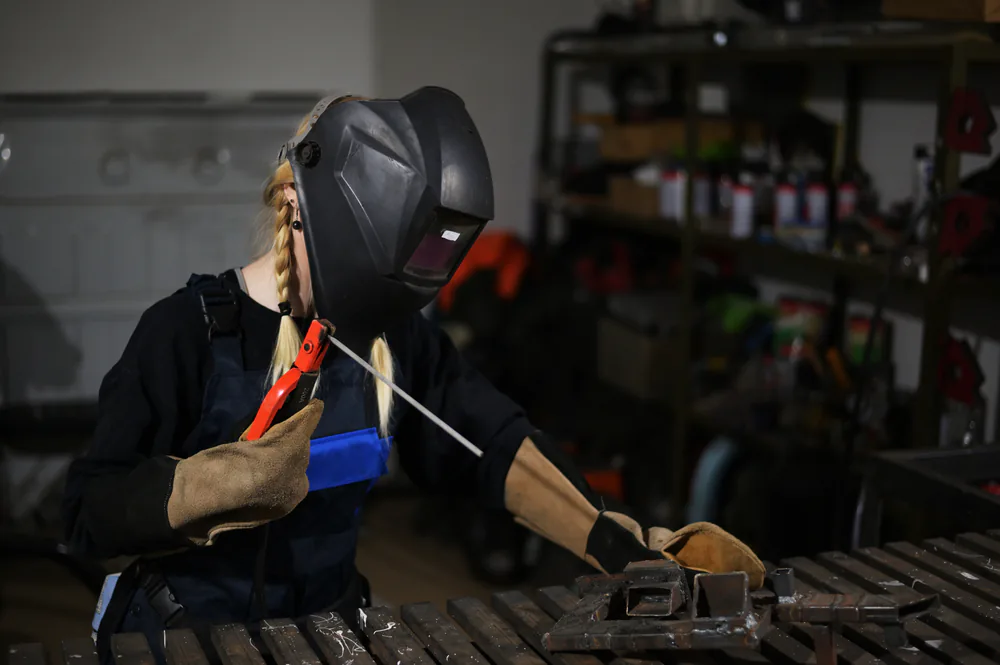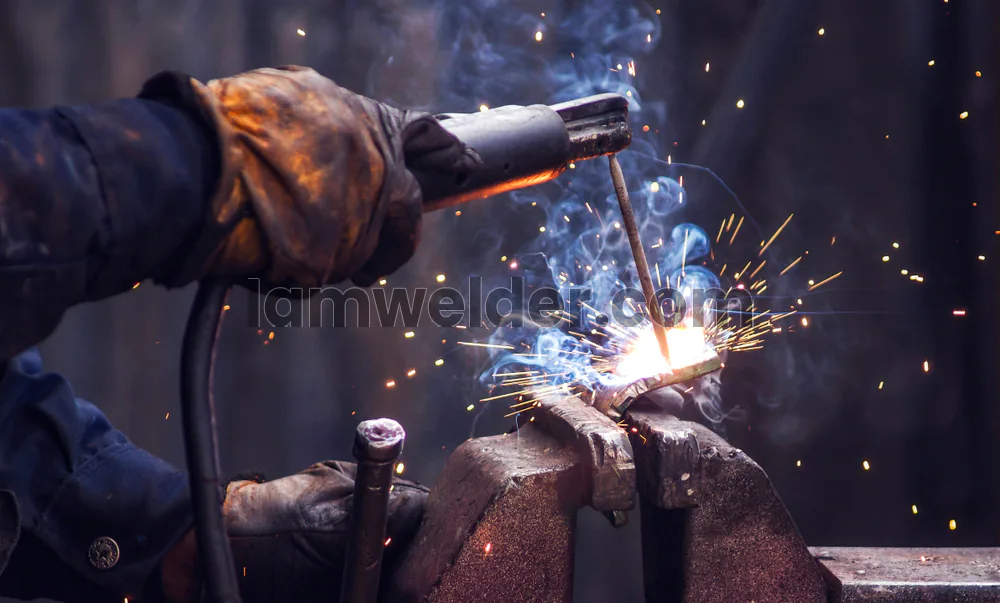Informational
The History of Welding and Its Evolution Over Time

History Time Line of a Welding
Prehistoric Times
- Welding is believed to have been used in the Bronze Age to create lap joints for small gold boxes and in the Iron Age to weld iron together.
Middle Ages
- Blacksmithing flourishes and hammered-iron goods become widespread.
1800s
- Sir Humphry Davy used a battery to create an arc between two carbon electrodes, marking the beginning of electric welding.
- Gas welding and cutting are also developed.
- Resistance welding becomes viable once arc welding with carbon and metal arcs is established.
- C.L. Coffin is granted the first US patent for arc welding.
- Stick electrodes and various resistance welding techniques are also developed.
- Gas welding and cutting are refined and developed further.
1900s
- The American Welding Society was founded.
- Automatic welding is introduced.
- Various welding electrodes are being developed.
- Extensive research is conducted on externally applied gases for arc and weld area shielding.
- Stud welds are developed.
- The submerged arc welding process becomes popular.
- Gas tungsten arc welding (GTAW) is developed.
1930s
- Atomic hydrogen welding and shielded metal arc welding (SMAW) are developing.
- The process of electro-slag welding is developed.
1950s
- Plasma arc welding (PAW) is being developed.
- Laser beam welding (LBW) is being developed.
- Electron beam welding (EBW) is developing.
1980s
- Friction stir welding (FSW) is developing.
- Ultrasonic welding (USW) is developing.
2000s
- Welding continues to evolve, and new techniques and technologies are being developed.
- Focus on Safety Equipment
Welding History in the Longer Run
Welding has been practiced for hundreds of years, dating back to prehistoric times. In this article, we will look at the evolution of welding over the years.
The Dark Ages
The earliest examples of welding date back to the Bronze Age, when lap joints were pressure welded together to form small gold boxes. These containers are thought to have been made around 2,000 years ago. People in Egypt and the eastern Mediterranean learned how to weld iron together during the Iron Age.
Blacksmithing flourished in the Middle Ages, resulting in the widespread production of hammered-iron goods. However, welding as we know it today did not emerge until the nineteenth century.
The 1800s: The Beginning of Electric Welding
Sir Humphry Davy used a battery to spark an arc between two carbon electrodes in 1800. This was the start of electric welding. Around the mid-nineteenth century, the electric generator was invented, and arc lighting quickly followed. In the 1800s, gas welding and cutting were also pioneered.
Resistance welding became a viable option for combining materials after arc welding with a carbon arc and a metal arc was established. Auguste De Mertens of France’s Cabot Laboratory used an arc’s heat to join lead plates for storing batteries in 1881. Nikolai N. Benardos, one of his students, later received a welding patent. Benardos and Stanislaus Olszewski were granted patents in the United Kingdom in 1885 and in the United States in 1887.
In 1890, C.L. Coffin of Detroit was the first person who received the first US patent for arc welding. This was the first time molten metal from an electrode was seen being transferred across an arc and used as filler metal in a welding joint. N.G. Slavianoff proposed using the same concept to cast metal in a mould across an arc around the same time.
The Early 1900s and the Role of World War I
Strohmenger introduced a coated metal electrode to the UK in the early 1900s. The arc became more stable after a thin layer of clay or lime was applied. Around the same time, Oscar Kjellberg, a Swedish inventor, invented a covered or coated electrode. Stick electrodes were created by dipping pieces of bare iron wire in thick carbonate and silicate solutions and then drying them.
During this time, resistance welding techniques such as spot welding, seam welding, projection welding, and flash butt welding were also developed. Elihu Thompson invented resistance welding and filed patents for it between 1885 and 1900. A German named Goldschmidt invented thermite welding in 1903, which was first used to connect railroad tracks.
During this time, gas welding and cutting were also refined and developed. The invention of the blow torch in 1887, as well as the subsequent liquefaction of air, aided the advancement of welding and cutting. Until the turn of the century, hydrogen and coal gas were the primary sources of oxygen. In 1900, however, a torch that could be used with low-pressure acetylene was invented.
During World War I, welding was widely used to meet the enormous demands of the armaments industry. As a result, several factories in the United States and Europe started manufacturing welding equipment and electrodes.
1919: American Society
Comfort Avery Adams and 20 other veterans who had served on the Wartime Welding Committee of the Emergency Fleet Corporation during World War I founded the American Welding Society in 1919. The society is a non-profit organization dedicated to the advancement of welding and related technologies.
Even though C.J. Holslag invented alternating current in 1919, it wasn’t widely used until the heavy-coated electrode became popular in the 1930s.
1920: Automatic Welding and Gas Shielding
In 1920, automatic welding was first used in industry. It used direct current with bare electrode wire, used arc voltage to control the feed rate, and was powered by arc voltage. P.O. Nobel of General Electric Company is credited with developing automatic welding. Worn motor shafts and crane wheels were given new life as a result of this. It has been used in the automotive industry to make rear axle housings.
In the 1920s, various welding electrodes began to emerge. Many people in the 1920s disagreed on whether heavy-coated rods were superior to lighter-coated rods. Langstroth and Wunder of A.O. Smith invented the extruded, heavy-coated electrodes in 1927. In 1929, the Lincoln Electric Company began producing and selling extruded electrode rods to the general public. By 1930, the industry was frequently using protective covers for electrodes. With the introduction of welding rules requiring the use of higher-grade weld metal, the use of covered electrodes increased.
In the 1920s, extensive research was conducted on the effects of using externally delivered gases to protect the arc and weld region. Because of the presence of oxygen and nitrogen in the surrounding air during welding, welds were frequently brittle and porous. The investigation employed gas shielding techniques. Alexander and Langmuir conducted their research in hydrogen-filled chambers. They started with carbon electrodes and then switched to tungsten electrodes. The hydrogen was converted to atomic hydrogen in the arc. It was then blasted out of the arc, where it burned and was converted to molecular form. This arc produced 1.5 times the heat of an oxyacetylene flame. The technique eventually became known as “atomic hydrogen welding.”
1930
Stud welding, a method of attaching wooden decks to metal substructures, was invented by the New York Navy Yard in 1930. Stud welding is becoming increasingly popular in the construction and maritime industries.
In 1930, the submerged arc welding process, an automated method of welding, also gained popularity. Submerged arc welding was developed by the National Tube Company for use in a pipe factory in McKeesport, Pennsylvania, to create longitudinal seams in pipes. Linde Air Products Company purchased the patent for this process and rebranded it as Unionmelt welding. During the 1938 military buildup, it was widely used in shipyards and ammunition factories, and it is still a popular welding method today.
1940
The gas tungsten arc welding (GTAW) process, also known as tungsten inert gas (TIG) welding, was invented in 1890 by C.L. Coffin, who proposed welding in a nonoxidizing gas atmosphere. H.M. Hobart, who used helium for shielding, and P.K. Devers, who used argon, expanded on the concept in the late 1920s. This method was especially useful for welding magnesium, as well as aluminum and other nonferrous metals.
During World War II, there was a significant increase in the demand for welders. The US government established welder training programs, and more efficient welding equipment was developed. During this time, the shielded metal arc welding process, also known as stick welding, became popular.
1950
Gas metal arc welding (GMAW), also known as metal inert gas (MIG) welding, was invented in the 1950s. To protect the weld from contamination, this method employs a wire electrode and an inert gas. GMAW became popular in the aerospace and automotive industries because it was a faster and more efficient method of welding.
1960
The flux-cored arc welding (FCAW) process was invented in the 1960s. This method is similar to GMAW, but it employs a wire electrode that is filled with flux, a substance that aids in the protection of the weld from contaminants. FCAW is a faster and more efficient method of welding, especially for outdoor applications.
1970
The plasma arc welding (PAW) process was developed in the 1970s. This method employs a constrained arc to generate a plasma jet, which is then used to melt the metal and form a weld. PAW is a precise and efficient welding method, especially for thin materials.
2000
Welding technology continued to advance at a rapid pace after the year 2000. One significant advancement was the use of lasers for welding, which enabled precise and efficient welding of thin materials. This technology was particularly useful in the automotive industry, where lightweight materials were gaining popularity. Another significant advancement was the creation of hybrid welding processes, which combined various welding techniques to achieve the best results. These hybrid processes were used in a variety of industries, including aerospace, construction, and manufacturing, and they frequently included the use of lasers or other high-tech tools.
In addition to these technological advancements, there were a number of advancements in welding materials. For example, scientists began to investigate the use of new alloys and composites that were stronger and more corrosion-resistant than traditional materials. This resulted in the development of more durable and dependable welds, which were highly sought after in industries such as oil and gas, transportation, and infrastructure.
Another significant change in welding after 2000 was the increased emphasis on safety and environmental concerns. Because welding can emit harmful fumes and particles, there has been a push to develop more environmentally friendly welding processes. This included the use of fume extraction systems and other safety precautions to keep welders safe from harmful substances. There was also a growing recognition of the significance of proper welding training and education, as it is a skilled trade requiring a high level of expertise. As a result, the number of welding-focused educational programs and certification programs increased, helping to ensure that welders were well-trained and competent in their work.
Informational
How to Weld If You Have Long Hair? Pro Welder’s Tips

Any welding operation that you perform puts you and anyone else in the area in danger of a number of different things. As a result, it is completely reasonable for you to be concerned about preventing your hair from becoming entangled in any welding equipment and posing a threat to your health. In this article, I will talk about how you can safely weld if you have long hair.
If you want to weld while having long hair, a French braid is the best option for keeping your hair together. This will help you in tying your hair and hold it together behind your neck. The French braid should keep the hair compact and close to your head’s shape, and it also allows you to wear a welding helmet. As a result, you will be able to wear full safety equipment.
When you are dealing with hot weld spatters, having long hair can present a particularly difficult challenge. Therefore, if you are interested in learning more about how you can safely weld with long hair, continue reading the rest of this article, where I will discuss the topic in greater detail and share some helpful hints.
How Your Long Hair Can be an Issue While Welding?
Welding procedures, as I indicated earlier, expose the operator as well as anybody else in the vicinity of the workplace to a wide variety of risks. A project involving welding presents a number of potential dangers and threats; it is important that you be aware of these issues in order to protect not only yourself but also others around you. Especially when dealing with spatters, it is easy for things to go wrong if you have long hair.
Before we look at all of the tips you may weld with long hair, we need to first understand the potential risks you run and everything that might go wrong. Long hair poses a unique set of challenges when it comes to welding. A few are mentioned below:
- Spatters are your hair’s worst enemy.
- UV rays can permanently damage your hair.
- With long hair, grinders can cause serious accidents.
Let’s look at these problems one by one:
1. Take Spatters Seriously
The spatter, sparks, and heat generated by the arc provides the greatest challenge throughout the welding process since they may travel up to 35 feet and enter any nearby place. You will want to provide enough protection for your long hair if you are going to be in an atmosphere like this.
Not just your hair, but everything else that might catch fire should be kept at least 35 feet away from the welding location. In addition, a fire extinguisher should never be far away. In the event that a fire breaks out.
2. UV Rays Can Damage Your Hair Permanently
Molten metals, welding arcs, and ultraviolet radiation will be present in the work environment while welding is being done. The interaction of all these factors puts you at an increased risk of serious burns. The actual welding arc may reach temperatures of up to 10,000 degrees Fahrenheit, making it one of the hottest processes possible.
And believe me when I say that you do not want that welding arc to get anywhere near your hair. Your hair will suffer a significant amount of damage as a result, and it is possible that it could even be burned.
3. Grinder Can Give You Nightmares
The usage of grinders is another factor that may create issues for your lengthy hair. Using grinders and welding go hand in hand when working with metals. Therefore, if you are a welder, you will most likely make extensive use of the grinder. And grinders are really your worst enemy when it comes to your long hair.
When you’re working, you can find yourself crouching over a grinder, which can cause serious accidents if you don’t protect your hair properly.
Tips from a Pro Welder to Protect Your Long Hair When Welding
Now you know what the most obvious dangers that you have when welding with long hair. The next step is to tell you how you can keep yourself safe from those dangers.
Here are a few of the tips that you can consider:
- Braid your hair while welding
- Put your hair in a tight knot behind your neck
- Consider buying a welding cap
- You can use a bandana too if you are a bandana lover
Let’s discuss these tips one by one:

1. Braiding is the Best Option You Have
Welding hoods, helmets, or shields will provide the optimum amount of protection from any sparks, heat, UV rays, flash burns, or infrared light that may be present. They will protect not only your face and neck but also your eyes and hair. As a result, I feel that acquiring one is the best approach to protecting oneself.
Welding hoods are often made of cotton or leather and are rather light in weight and can go easily along with helmets. Make sure that whichever helmet you decide to purchase, is not too heavy and that it is comfortable to wear. It must also include a spatter barrier, the ability to be modified, a sensor bar, and the availability of replacement components.
2. You Can Simply Put Your Hair in a Tigh Knot
The most conventional and easiest technique for a welder operator to keep their long hair out of their face is to pull it back into a tight bun. Wrap an elastic band over your buns and secure them in place to prevent them from falling on your face.
If there are any unruly hairs, just use bobby pins to push them up and you should be OK. Anything that prevents your hair from falling on your face will suffice.
3. Consider Buying a Welding Cap
A welding cap is a good option if you want something that is both lightweight and comfortable. It must adequately shield your head from any hot metal, sparks, or splatters that may be present.
Not only they are effective in protecting your hair, but they are also made completely of cotton, making them incredibly breathable and also preventing sweat from pouring down your eyebrows while working.
4. Bandana is Another Option That You Can Use
Braids are not easy to create for everyone, and they may even be difficult to perform on a regular basis. If you don’t know how to braid my easiest suggestion would be to put a bandana over your head and tuck all of your hair within.
When welding, sparks will fly everywhere, and this will keep you safe. Make use of bobby pins or a bun to tuck in all of the ends. Bandanas aren’t my first choice for headgear. But it works. It’s a good option to have in case you don’t know how to braid your hair.
Few Other Safety Measures That You Need to Take
In addition to your hair, there are a few other parts of your body that need your attention. Some of these essential measures for ensuring your safety are listed below:
- Protect your eyes at all cost
- Always keep a fire extinguisher in your shop
- Wear protective clothing
- Make habit of using respirators
- Beware of leakages in your welding system
- Keep your welding space clean
Let’s discuss them one by one:
1. Protect your eyes at all cost
Be sure to always wear safety glasses in your workplace to protect your eyes from flying debris, which is often composed of metal. If you routinely do welding tasks, you will be exposed to a significant amount of flying debris.
You should make it a routine to put them on as soon as you come in the door; this will ensure that you are protected at all times.
2. Always keep a fire extinguisher in your shop
You shouldn’t be shocked if anything catches fire at some time during a welding operation because of all of the intense heat and sparks that are produced throughout the process. Because fires are a very real risk, you should always have an extinguisher on hand in case one breaks out.
3. Wear protective clothing
If you’ve ever imagined yourself beginning your first welding project in a pair of shorts, an old t-shirt, and a pair of flip-flops, you should rethink that idea. Wearing the necessary protective clothing at all times when welding is required if you wish to prevent injuries to your body, notably burns, that may be caused by the process.
4. Make habit of using respirators
You should always wear a respirator if you are going to be dealing with metals or any other materials that have the potential to emit harmful vapors.
Welding or cutting certain materials may produce a welding plume, which is a combination of hazardous gases, fumes, and smoke. This is not the type of thing you want to breathe in if you want to keep your lungs healthy and prevent respiratory issues.
5. Beware of leakages in your welding system
There is a good chance that you have pressurized containers in your welding shop that hold liquids or gases. Take extra precautions to check that none of those containers or the items that you are attaching to them have any leaks in them.
See my other article to know more about leakages and how to detect them.
6. Maintain your equipment
If you want to establish the safest possible working environment for your welding projects, you need to give your equipment a lot of TLC and make sure it’s in good operating order at all times. If your welding equipment and tools are in disrepair, an accident is almost waiting to happen every time you use them. However, the vast majority of incidents of this kind are avoidable if proper care is taken with the equipment.
Wrapping it Up
When it comes to welding, safety is the most important thing to keep in mind at all times. Because because welding involves a significant amount of fire and spatters, it is essential that you take a significant amount of precaution to protect your hair. I really hope that you’ll be able to keep your hair under control while welding thanks to the advice that’s been provided in this article.
Weld Types
Different Welding Methods: Applications of Each Method

Welding is joining two pieces of metal together by melting and cooling them until they become one piece. Welding processes include:
- Oxyacetylene welding
- Shielded metal arc welding (Stick)
- Gas tungsten arc welding (TIG)
- Gas metal arc welding (MIG)
- Flux-cored arc welding
- Torch or oxyfuel brazing
Some methods employ both heat and pressure, while others employ only heat. Welding is commonly used to construct automobiles, airplanes, and buildings. Other metal-cutting methods, such as oxy-acetylene and plasma arc cutting, use heat or electricity to cut through metal.
1. Oxyacetylene welding
Oxyacetylene welding (OAW) is a method of joining two pieces of metal using heat generated by the combustion of oxygen and acetylene gas.
Torch brazing (TB) is similar, but the metal is not completely melted. Instead, a special alloy is melted and used to join the two metal pieces.
Oxyfuel gas cutting (OFC) is a method of cutting metal that uses the same tools and gases as OAW and TB.
To generate heat and bond the metal, all of these methods employ a torch and special gases. They are frequently used on small or thin metal pieces.
Applications:
- Welding and brazing thin or small pieces of metal
- Welding and brazing dissimilar metals
- Cutting and piercing metal
Situations to Avoid:
- Welding thick or heavy sections of metal
- Welding high alloy or stainless steel
- Welding in high wind or outdoor conditions (due to the open flame)
- Welding in confined spaces (due to the production of harmful gases)
2. Shielded metal arc welding (Stick)
Shielded metal arc welding, or SMAW, is a way of welding metal together using an electrode that is coated with a special kind of flux.
The electrode melts and becomes a part of the welded metal. To do SMAW welding, you need a transformer, two welding cables, a work clamp, and an electrode holder.
There are many different types of electrodes you can use for SMAW welding, so you can choose the one that is best for your project. With SMAW welding, you can join different types and thicknesses of metal using the same machine.
Applications:
- Welding thick or heavy sections of metal
- Welding in outdoor conditions
- Welding in dirty or contaminated environments
- Welding on dirty or painted surfaces
Situations to Avoid:
- Welding thin or small pieces of metal (more suited for TIG welding)
- Welding high alloy or stainless steel (can affect the quality of the weld)
- Welding in confined spaces (due to the production of harmful gases)
- Welding in the presence of high winds (due to the electric arc)
3. Gas tungsten arc welding
GTAW, or gas tungsten arc welding, is a method of joining metal using a tungsten electrode. The tungsten electrode generates an electric arc, which melts the metal being welded as well as the end of the filler metal, which is manually applied.
Shielding gas is emitted from the welding gun to protect the molten weld metal from dirt and other contaminants. A foot or thumb switch can be added to the GTAW equipment to help the welder better control the welding.
GTAW welding produces very clean, high-quality welds, but it is slower and requires more skill than other welding methods. It is particularly useful for joining metal alloys that can only be joined with GTAW.
Applications:
- Welding thin or small pieces of metal
- Welding high alloy or stainless steel
- Welding in outdoor conditions (with proper shielding gas)
- Welding materials with high levels of contaminants or impurities
- Welding in high-precision environments
Situations to Avoid:
- Welding thick or heavy sections of metal (more suited for MIG welding)
- Welding in high production environments (slower process)
- Welding in confined spaces (due to the production of harmful gases)
- Welding in the presence of high winds (due to the electric arc)
4. Gas metal arc welding (MIG)
Mig welding is a type of arc welding that uses a continuously supplied wire electrode and gas to weld metal together.
It is becoming more popular because it is easier to learn than other types of welding, like stick and tig welding, and it is faster because you don’t have to stop and change the electrode as often.
Mig welding also creates less slag and spatter, which makes it more enjoyable to use and easier to clean up.
However, MIG welding equipment is more expensive and the MIG gun, which is the portable part of the equipment, can be difficult to use in small spaces. Mig welding also requires a shielding gas to work, so it is not as good for outdoor use.
Applications:
- Welding thick or heavy sections of metal
- Welding high alloy or stainless steel
- Welding in high-production environments
- Welding in outdoor conditions (with proper shielding gas)
Situations to Avoid:
- Welding thin or small pieces of metal (more suited for TIG welding)
- Welding in confined spaces (due to the production of harmful gases)
- Welding in the presence of high winds (due to the electric arc)
- Welding materials with high levels of contaminants or impurities (can affect the quality of the weld)
5. Flux-cored arc welding
Flux-cored arc welding, or FCAW, is a method of joining metal using a special type of electrode wire known as a flux core wire.
The wire is fed from a spool continuously through the welding equipment and out of the gun. The welding current flows through the equipment, melting the wire and the base metal.
Some flux core wires generate their own shielding gas as they melt, while others require the use of additional shielding gas. As the wire melts, it produces a gaseous cloud that shields the weld surface and removes impurities from the molten metal.
After the weld is completed, a layer of slag must be removed from the weld’s top. Despite this additional step, FCAW is a popular welding technique because it produces high-quality welds quickly and is very versatile.
FCAW equipment is similar to that used in gas metal arc welding (GMAW), and both methods are semiautomatic, which means that the wire is fed automatically but the welder moves the gun manually. Welding supply stores and other retailers stock FCAW equipment and filler metals.
Applications:
- Welding thick or heavy sections of metal
- Welding in outdoor conditions (with proper shielding gas)
- Welding in high-production environments
- Welding in dirty or contaminated environments
Situations to Avoid:
- Welding thin or small pieces of metal (more suited for TIG welding)
- Welding high alloy or stainless steel (can affect the quality of the weld)
- Welding in confined spaces (due to the production of harmful gases)
- Welding in the presence of high winds (due to the electric arc)
Comparison Table:
| Welding Process | Applications | Situations to Avoid |
|---|---|---|
| Oxyacetylene welding | Welding and brazing thin or small pieces of metal; welding and brazing dissimilar metals; cutting and piercing metal | Welding thick or heavy sections of metal; welding high alloy or stainless steel; welding in high wind or outdoor conditions; welding in confined spaces |
| Shielded metal arc welding (Stick) | Welding thick or heavy sections of metal; welding in outdoor conditions; welding in dirty or contaminated environments; welding on dirty or painted surfaces | Welding thin or small pieces of metal; welding high alloy or stainless steel; welding in confined spaces; welding in the presence of high winds |
| Gas tungsten arc welding (TIG) | Welding thin or small pieces of metal; welding high alloy or stainless steel; welding in outdoor conditions (with proper shielding gas); welding materials with high levels of contaminants or impurities; welding in high-precision environments | Welding thick or heavy sections of metal; welding in high production environments; welding in confined spaces; welding in the presence of high winds |
| Gas metal arc welding (MIG) | Welding thick or heavy sections of metal; welding in high production environments; welding in outdoor conditions; welding on dirty or painted surfaces | Welding thin or small pieces of metal; welding high alloy or stainless steel; welding in confined spaces; welding in the presence of high winds |
| Flux-cored arc welding | Welding thick or heavy sections of metal; welding in high production environments; welding in outdoor conditions; welding on dirty or painted surfaces | Welding thin or small pieces of metal; welding high alloy or stainless steel; welding in confined spaces; welding in the presence of high winds |














